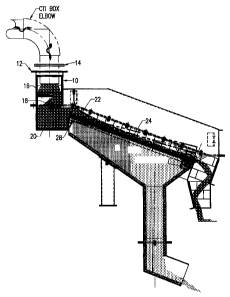Une partie des informations de ce site Web a été fournie par des sources externes. Le gouvernement du Canada n'assume aucune responsabilité concernant la précision, l'actualité ou la fiabilité des informations fournies par les sources externes. Les utilisateurs qui désirent employer cette information devraient consulter directement la source des informations. Le contenu fourni par les sources externes n'est pas assujetti aux exigences sur les langues officielles, la protection des renseignements personnels et l'accessibilité.
L'apparition de différences dans le texte et l'image des Revendications et de l'Abrégé dépend du moment auquel le document est publié. Les textes des Revendications et de l'Abrégé sont affichés :
| (12) Brevet: | (11) CA 2582122 |
|---|---|
| (54) Titre français: | CRIBLE A CHARBON REGLABLE |
| (54) Titre anglais: | ADJUSTABLE COAL SCREENING APPARATUS |
| Statut: | Octroyé |
| (51) Classification internationale des brevets (CIB): |
|
|---|---|
| (72) Inventeurs : |
|
| (73) Titulaires : |
|
| (71) Demandeurs : |
|
| (74) Agent: | GOWLING WLG (CANADA) LLP |
| (74) Co-agent: | |
| (45) Délivré: | 2010-09-21 |
| (22) Date de dépôt: | 2007-03-13 |
| (41) Mise à la disponibilité du public: | 2007-09-14 |
| Requête d'examen: | 2009-11-26 |
| Licence disponible: | S.O. |
| (25) Langue des documents déposés: | Anglais |
| Traité de coopération en matière de brevets (PCT): | Non |
|---|
| (30) Données de priorité de la demande: | ||||||
|---|---|---|---|---|---|---|
|
Dispositif de filtrage et de triage des particules de charbon muni d'un bac pour la réception du charbon broyé. Le bac est surmonté d'un déversoir qui achemine les particules à un crible pivotant comportant de multiples ouvertures servant à trier les particules de charbon. Un dispositif à came permet de varier l'angle du crible par rapport à l'horizontale afin de modifier la vitesse de déplacement vers le bas des particules de charbon sur le dispositif de filtrage.
A screening and sorting assembly for coal particles includes a bin for receiving crushed coal. The bin is provided with a weir over which the coal particles are passed onto a pivoted screen assembly having a plurality of openings therethrough for sorting the coal particles. A cam arrangement is provided for varying the angle of the screening assembly relative to the horizontal to vary the speed of flow of the coal particles downwardly over the screening assembly.
Note : Les revendications sont présentées dans la langue officielle dans laquelle elles ont été soumises.
Note : Les descriptions sont présentées dans la langue officielle dans laquelle elles ont été soumises.

Pour une meilleure compréhension de l'état de la demande ou brevet qui figure sur cette page, la rubrique Mise en garde , et les descriptions de Brevet , États administratifs , Taxes périodiques et Historique des paiements devraient être consultées.
| Titre | Date |
|---|---|
| Date de délivrance prévu | 2010-09-21 |
| (22) Dépôt | 2007-03-13 |
| (41) Mise à la disponibilité du public | 2007-09-14 |
| Requête d'examen | 2009-11-26 |
| (45) Délivré | 2010-09-21 |
Il n'y a pas d'historique d'abandonnement
Dernier paiement au montant de 253,00 $ a été reçu le 2024-03-04
Montants des taxes pour le maintien en état à venir
| Description | Date | Montant |
|---|---|---|
| Prochain paiement si taxe générale | 2025-03-13 | 624,00 $ |
| Prochain paiement si taxe applicable aux petites entités | 2025-03-13 | 253,00 $ |
Avis : Si le paiement en totalité n'a pas été reçu au plus tard à la date indiquée, une taxe supplémentaire peut être imposée, soit une des taxes suivantes :
Les taxes sur les brevets sont ajustées au 1er janvier de chaque année. Les montants ci-dessus sont les montants actuels s'ils sont reçus au plus tard le 31 décembre de l'année en cours.
Veuillez vous référer à la page web des
taxes sur les brevets
de l'OPIC pour voir tous les montants actuels des taxes.
Les titulaires actuels et antérieures au dossier sont affichés en ordre alphabétique.
| Titulaires actuels au dossier |
|---|
| CERAMIC TECHNOLOGY, INC. |
| Titulaires antérieures au dossier |
|---|
| OSBORNE, LEE-RANSOM |
| SANDERS, SAMUEL G. |